Overview
The article titled "7 Insights on Public-Private Land Development Partnerships" underscores the pivotal role of public-private partnerships (PPPs) in land development. These partnerships are not merely beneficial; they are essential for enhancing infrastructure and service delivery. By merging the strengths of public oversight with the efficiency of the private sector, PPPs address the complexities faced in land acquisition. This includes navigating legal and regulatory challenges, which can often hinder progress. Successful case studies illustrate how these collaborations can lead to sustainable development practices, reinforcing their increasing relevance in today’s context.
Introduction
In the dynamic realm of land services, where energy and infrastructure projects are on the rise, Harbinger Land emerges as a leader in delivering customized solutions tailored to meet the unique demands of its clients. With the integration of advanced technologies such as AI-driven title research and GIS mapping, the company enhances operational efficiency, ensuring that the diverse needs of natural gas firms, solar developers, and municipalities are met with precision. As the industry transitions towards sustainable development and environmental stewardship, the strategic deployment of resources becomes paramount.
This article delves into the multifaceted landscape of public-private partnerships (PPPs), exploring their characteristics and advantages while showcasing the innovative models that are shaping the future of infrastructure development. Have you considered the complexities of land acquisition, including legal and regulatory challenges? With real-world examples and insights into effective risk management, we highlight the critical role of collaboration in navigating these complexities. The discussion aims to illuminate how Harbinger Land’s expertise can provide effective solutions, fostering a more sustainable and efficient future.
Harbinger Land | Comprehensive Solutions for Land Services in Energy and Infrastructure
Harbinger Land stands at the forefront of customized land services tailored for energy and infrastructure projects. Their comprehensive offerings include site and right-of-way acquisition, advanced title research solutions, GIS mapping, and efficient document imaging services. By leveraging cutting-edge technology—such as AI-powered title research software and highly integrated GIS modeling—Harbinger Land significantly enhances operational efficiency and client satisfaction.
The firm's seasoned team excels at rapidly mobilizing large groups to meet diverse demands. Clients, ranging from natural gas firms to solar developers and local governments, benefit from prompt and accurate services that cater to their unique needs. This strategic approach not only streamlines land acquisition processes but also aligns with the increasing focus on sustainable development and environmental stewardship within the industry.
The application of GIS modeling facilitates efficient easements, enabling faster and more economical land acquisition—an essential factor for renewable energy initiatives. As highlighted by the POWER UP pilot initiatives, integrating technical, economic, and legal considerations is vital for success in renewable efforts. Furthermore, emerging trends point toward a heightened emphasis on resilient and sustainable development, bolstered by advances in digital tools for land management.
By embracing ESG principles, Harbinger Land positions itself to adeptly navigate the challenges presented by climate change. A case study showcasing improved decision-making through technology illustrates how accurate data minimizes risks and maximizes investments in land acquisition. This reinforces the company's commitment to leveraging technology for enhanced project outcomes.
Public-Private Partnerships: Definition and Overview
Public-private land development partnerships involve collaborations between government organizations and private sector firms that represent strategic efforts aimed at enhancing the provision of community services and infrastructure. Public-private land development partnerships leverage the strengths of both sectors by merging governmental oversight with the efficiency and innovation characteristic of private enterprises.
As of 2025, public-private land development partnerships encompass various contractual arrangements, including those for the construction, operation, and maintenance of public assets. This framework is often designed to equitably distribute risks and benefits among the involved parties, and recent trends indicate a growing emphasis on public-private land development partnerships, particularly concerning [the 2030 Agenda](https://unece.org/media/economic cooperation and integration/Public-Private-Partnerships-(PPP)/news/recent), where infrastructure financing is critical.
Statistics reveal that IDB Invest oversees a substantial portfolio of $21 billion across 25 countries, underscoring the global importance of public-private land development partnerships in facilitating both land acquisition and infrastructure development. Successful case studies, such as Plaza Companies' expansion in hospitality, illustrate how public-private land development partnerships can adapt to market demands while enhancing portfolio diversity. This growth not only meets the increasing needs of the hospitality sector but also emphasizes the strategic importance of public-private land development partnerships for new project development.
The extensive benefits of public-private land development partnerships include improved service delivery, enhanced investment efficiency, and the ability to harness private sector innovation for public benefit. According to the Annual PPI Database Global Report, total investment in water initiatives in developing countries reached US$4.1 billion in 2015, highlighting the critical role of PPPs in infrastructure funding.
As the landscape evolves, it is essential for stakeholders in land acquisition and development to comprehend these dynamics. Directors of Land Acquisition should consider how public-private land development partnerships can be integrated into their strategies to foster improved outcomes and community benefits.
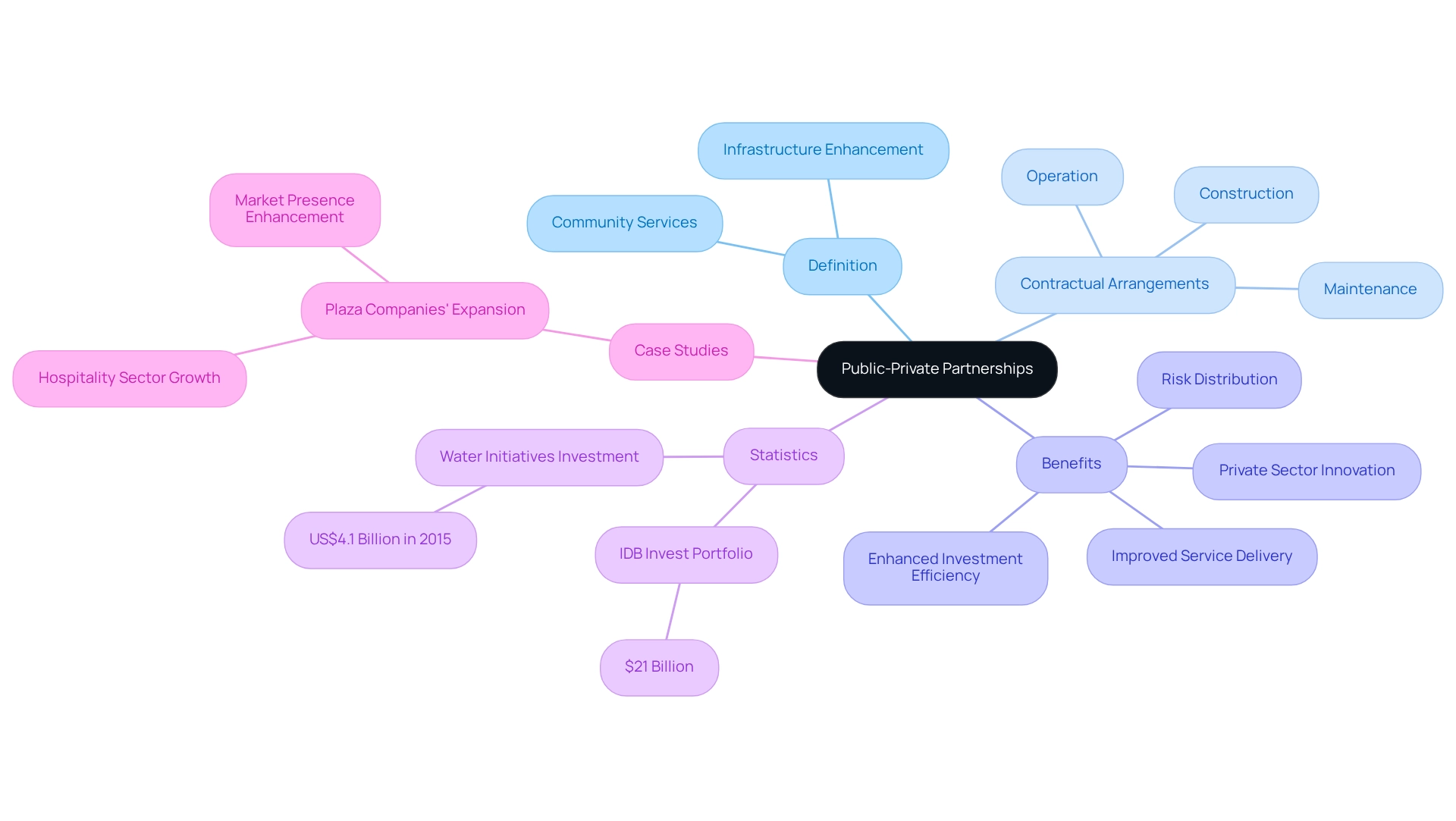
Key Characteristics of Public-Private Partnerships
Key characteristics of public-private land development partnerships are essential to understanding their value:
- Shared Risk: In public-private land development partnerships, both parties share the risks associated with the project, fostering an environment conducive to innovative solutions.
- Long-Term Commitment: These partnerships typically involve long-term contracts, which ensure sustained collaboration and investment in the project's success.
- Performance-Based Contracts: Payments are often linked to the achievement of specific performance metrics, incentivizing efficiency and accountability.
- Community Benefit Focus: The primary objective of public-private land development partnerships is to provide services or infrastructure that effectively meet community needs, reinforcing the partnership's commitment to public welfare.
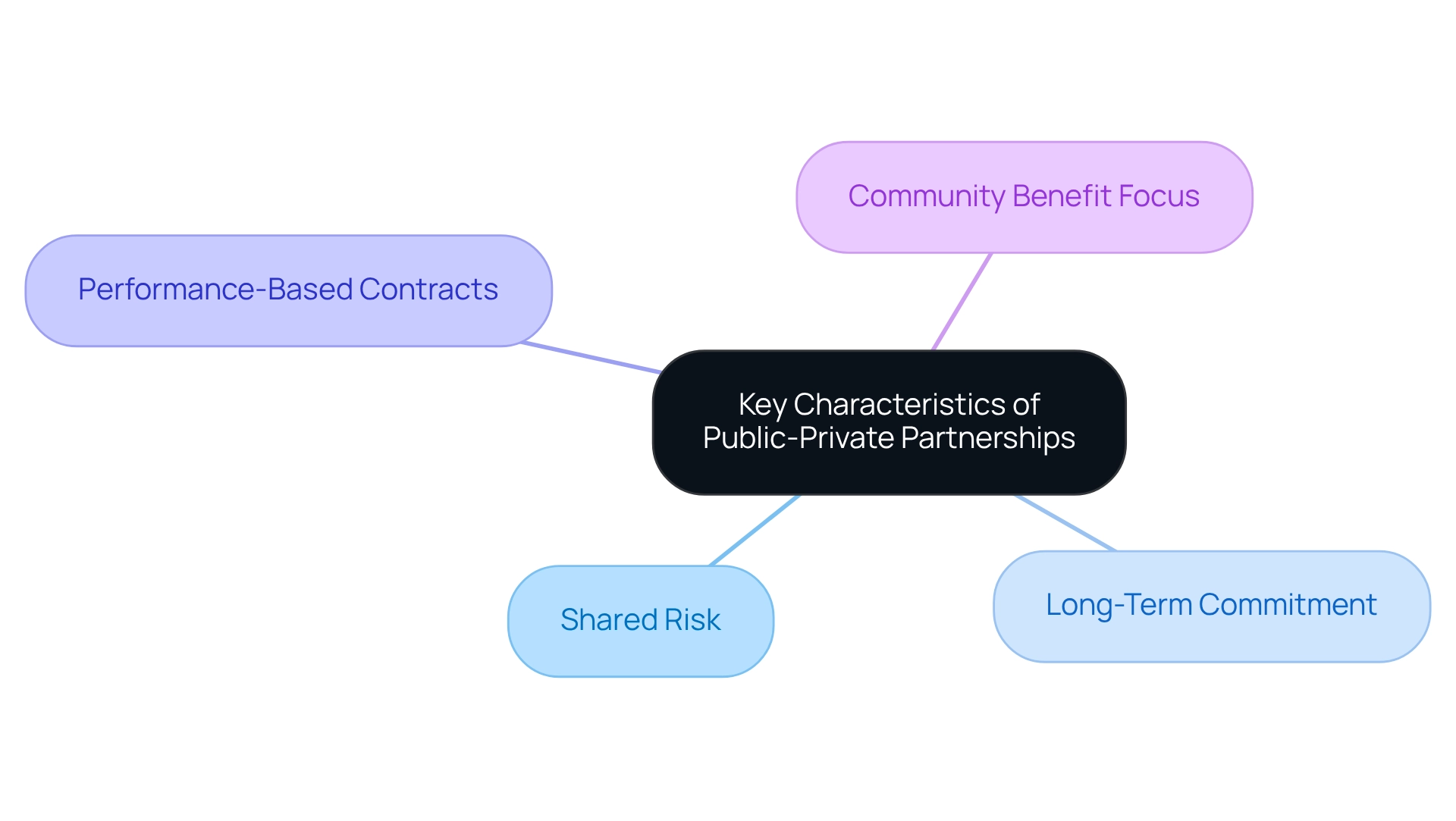
Types of Public-Private Partnerships Explained
Public-private partnerships (PPPs) represent a pivotal strategy in addressing [infrastructure development challenges](https://unece.org/media/economic cooperation and integration/Public-Private-Partnerships-(PPP)/news/recent), classified into several distinct types, each serving unique purposes:
- Build-Operate-Transfer (BOT): This model allows a private entity to construct and operate a facility for a predetermined duration before transferring ownership to the public sector. It ensures efficient task execution while maintaining public oversight post-operation.
- Design-Build-Finance-Operate (DBFO): In this arrangement, the private partner takes comprehensive responsibility for the design, construction, financing, and operation of the project. This approach streamlines processes and fosters innovation, leveraging private sector expertise throughout the project lifecycle.
- Concessions: Under this framework, the government authorizes a private entity to manage a communal service or facility for a specified timeframe, often incorporating revenue-sharing agreements. This model encourages private investment while ensuring governmental oversight.
- Joint Ventures: This type involves collaboration between public and private entities, pooling resources and sharing risks in development. Joint ventures enhance initiative viability by combining strengths from both sectors.
Public-private land development partnerships are increasingly relevant collaboration models as governments seek innovative solutions to infrastructure challenges, particularly in sustainable land use and conservation planning. As noted by the World Bank, "The complexity also means PPPs take longer to procure than traditional projects, which is a challenge when immediate infrastructure stimulus is needed." Furthermore, with governments exploring public-private land development partnerships for national digital ID systems and e-governance platforms, the significance of these collaborations continues to rise. Clarity in accounting for PPP liabilities is essential for fiscal responsibility and managing future obligations, underscoring the necessity for robust internal expertise in navigating these collaborations. Recent trends indicate that emerging technologies and digitalization are expected to foster more collaborations between the public and private sectors in various digital industries, further emphasizing the evolving landscape of such arrangements.
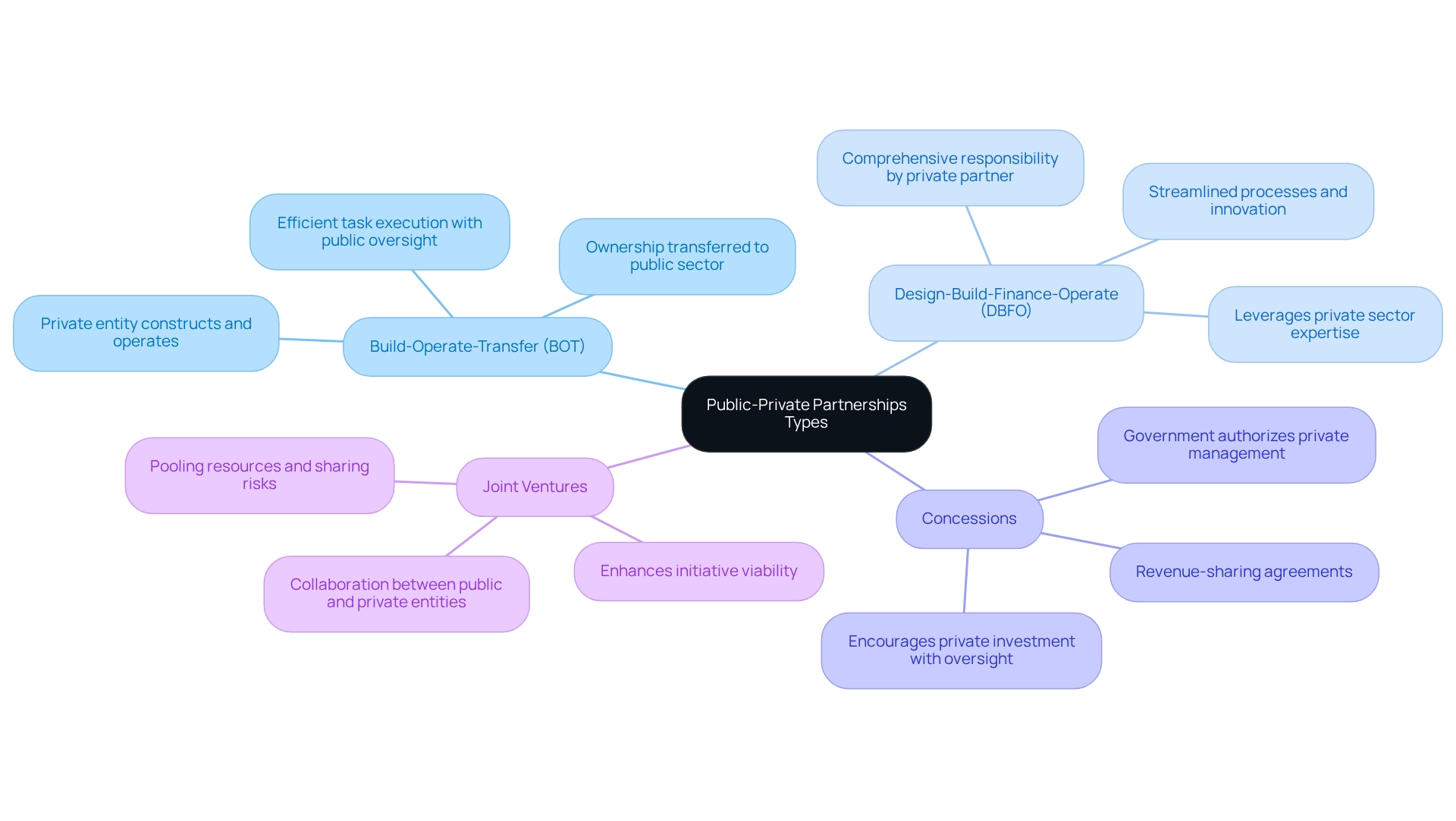
Advantages of Engaging in Public-Private Partnerships
Public-private land development partnerships offer numerous advantages that can significantly enhance land development efforts, including access to capital by effectively attracting private investment, which alleviates the financial burden on government entities and enables more ambitious projects. A prime example of public-private land development partnerships is the Arizona Commerce Authority and industry leaders investing $4.2 million into the WearTech Applied Research Center, showcasing the financial support available for such collaborations.
- Innovation and Efficiency: Private partners often introduce innovative solutions and operational efficiencies, leading to improved outcomes.
- The Plaza Companies' expansion into hospitality illustrates how public-private land development partnerships can stimulate growth in local markets, creating new jobs and boosting tourism revenue—critical metrics for evaluating local economic impact.
- Directors of Land Acquisition can harness these advantages by actively pursuing collaborations that align with their objectives, ensuring they maximize both financial and community benefits.
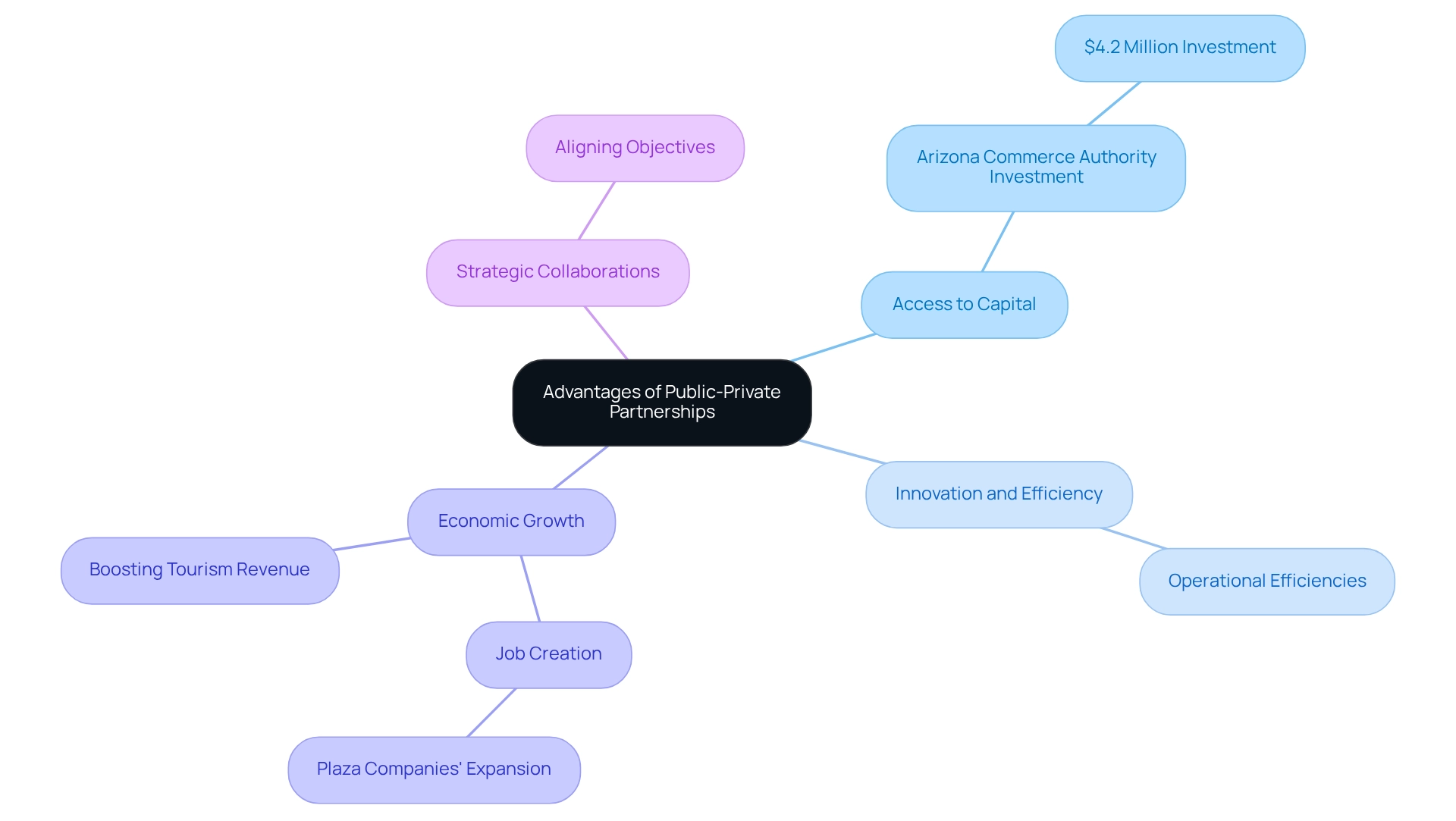
Disadvantages to Consider in Public-Private Partnerships
While public-private land development partnerships offer various advantages, they also come with significant disadvantages that require careful consideration.
- Complexity: The intricate structure of PPPs necessitates thorough negotiation and ongoing management, which can strain resources and expertise. This complexity often arises from the diverse roles and responsibilities defined in agreements, including Build Operate Transfer (BOT), Build Operate Own (BOO), Design-Build (DB), and Buy Build Operate (BBO) models, complicating execution.
- Long-Term Commitments: The extended duration of contracts, sometimes spanning decades—such as the 99-year lease term for the 407 ETR—can restrict governmental entities' flexibility to adapt to changing circumstances or priorities. This long-term commitment can hinder responsiveness to community needs and evolving environmental standards.
- Potential for Misalignment: Conflicting objectives between governmental and private partners can lead to disputes, particularly when profit motives clash with community interest goals. Such misalignments jeopardize outcomes and erode stakeholder trust.
- Higher Costs: Funding through PPPs can occasionally incur higher overall expenses compared to conventional financing methods. This is especially true if the private sector's profit margins are factored into the budget, potentially increasing taxpayer responsibility.
- Responsibility Issues: Ultimately, taxpayers may bear the financial burden of any deficiencies in PPP initiatives, raising concerns about accountability and the management of public resources. Understanding these financial implications is essential for parties involved in public-private land development partnerships. Recognizing these drawbacks is vital for those involved in land development as they navigate the intricacies of public-private land development partnerships and work towards sustainable outcomes.
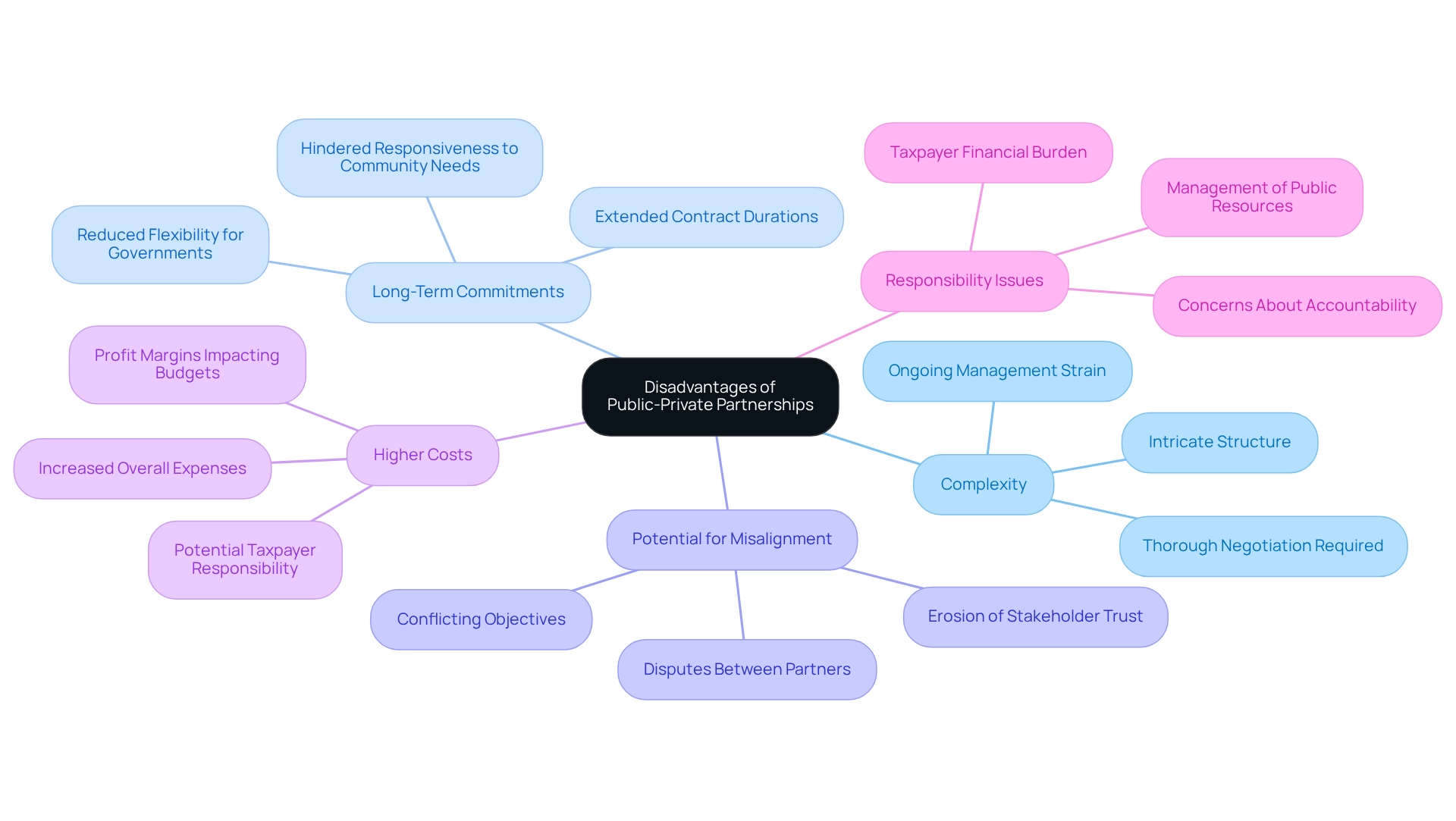
Real-World Examples of Successful Public-Private Partnerships
Numerous successful public-private land development partnerships underscore the effectiveness of this cooperative model in improving infrastructure and service delivery.
- Port of Miami Tunnel: This project exemplifies a strategic partnership between the Florida Department of Transportation and a private contractor, aimed at improving traffic flow and alleviating congestion in the bustling Miami area. The tunnel not only enhances connectivity but also supports economic growth by facilitating smoother transportation of goods and services. Regular maintenance is conducted on the tunnel's many safety systems, underscoring the importance of ongoing management in successful PPPs. Furthermore, the tunnel team reached a significant milestone of 100,000 work hours without a Lost Time Injury (LTI) in March, following a full year free of injuries achieved in August 2015, reflecting the team's commitment to safety and operational excellence. The development of the Delhi Metro Rail Corporation is a prime example of how public-private land development partnerships can revolutionize urban transport in Delhi, showcasing how effective collaboration between government and private entities can lead to significant improvements in public transit. The initiative has been pivotal in reducing travel times and increasing accessibility for millions of commuters.
- Highway 407 in Ontario: Developed through a PPP, this toll highway is recognized for its operational efficiency and substantial revenue generation. The collaboration has effectively handled the highway's upkeep and operations, guaranteeing a high-quality travel experience for users, and these examples highlight the potential of public-private land development partnerships to provide significant infrastructure solutions that address the needs of communities while promoting economic growth. Moreover, the Asian Development Bank (ADB) supports initiatives in developing member nations that generate economic and developmental effects through public and private sector activities, highlighting the global significance of public-private land development partnerships.
Managing Risks in Public-Private Partnerships
Effectively managing risks in public-private land development partnerships is crucial for ensuring their success and sustainability. To navigate the complexities of these partnerships, several key strategies emerge:
- Thorough Due Diligence: Conducting comprehensive assessments of potential partners and evaluating project feasibility is essential. This process helps identify risks early and ensures that all parties are aligned in their objectives.
- Clear Contractual Agreements: Establishing well-defined roles, responsibilities, and performance metrics within contracts mitigates misunderstandings and sets clear expectations for all stakeholders involved.
- Regular Monitoring and Evaluation: Implementing ongoing oversight mechanisms ensures compliance with contractual obligations and allows for the prompt addressing of any emerging issues, thereby safeguarding program integrity.
- Stakeholder Engagement: Actively involving all relevant parties in decision-making processes fosters collaboration and aligns interests, which is vital for the long-term success of PPP projects.
In the realm of operational risk management, research indicates that strategies aimed at reducing vulnerability are significantly more effective than those focused solely on mitigating external threats. A recent analysis revealed that all listed risk factors in PPP-MHPs recorded a very high level of severity, underscoring the critical need for effective risk management. Moreover, a study titled "Operational Risk Management in PPP Projects" identified 28 operational risk management strategies, emphasizing the necessity of providing exit mechanisms in contracts and establishing comprehensive performance evaluation systems. As W. Jiang highlighted, these strategies serve as a guideline for practitioners to select effective operational risk management approaches, thereby promoting the sustainable development of public-private land development partnerships. These insights underscore the importance of a proactive strategy for risk management in public-private land development partnerships, especially as the environment continues to evolve in 2025 and beyond. Harbinger Land customizes its services to address specific client needs, ensuring that risk management strategies are effectively implemented in alignment with objectives.
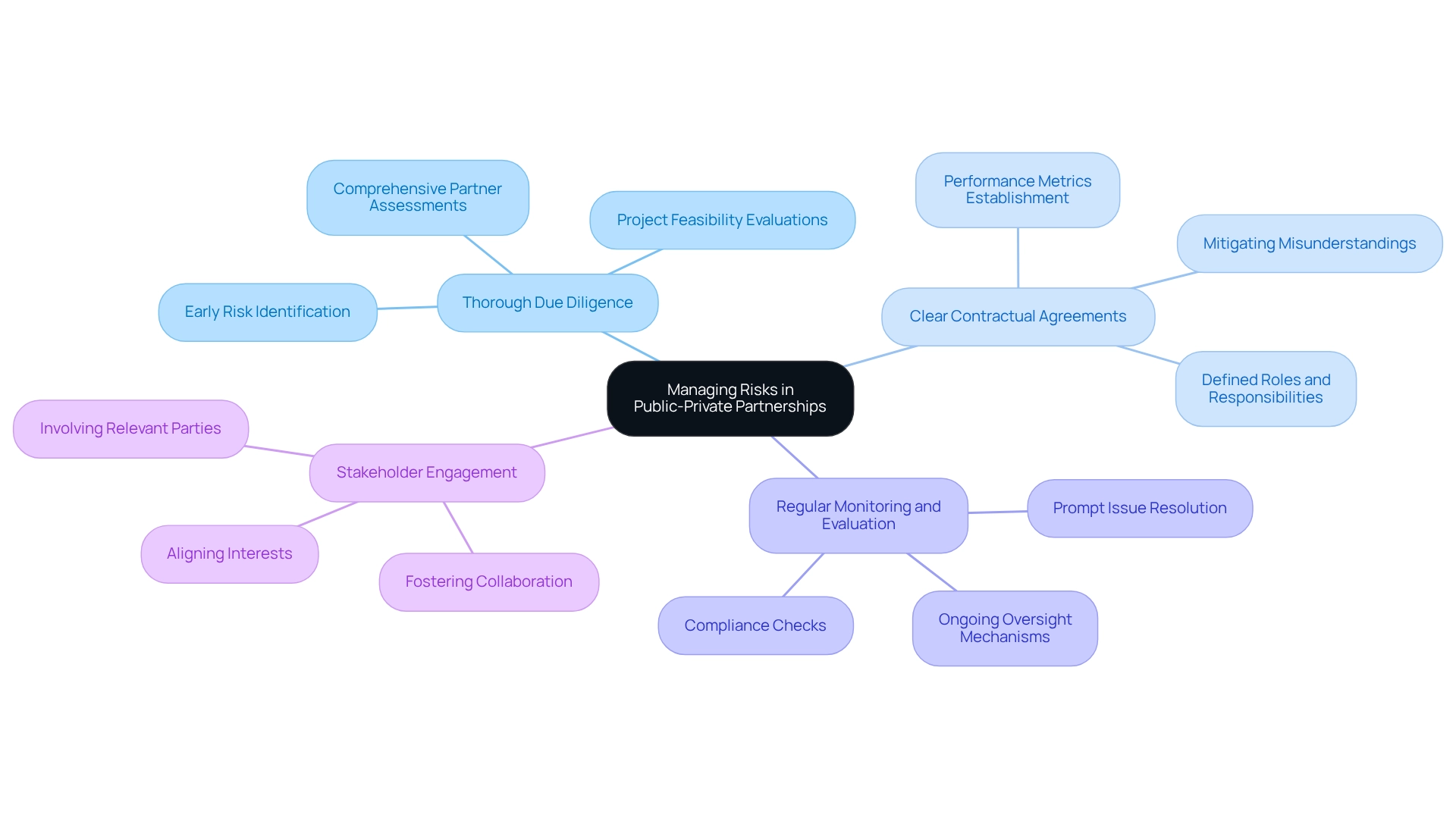
The Role of Stakeholder Collaboration in Public-Private Partnerships
Stakeholder collaboration is vital for the success of public-private partnerships (PPPs) in land development. Establishing strong connections between public and private organizations fosters trust and transparency, essential for navigating the complexities of commerce and managing intricate projects. Aligning objectives among stakeholders ensures that all parties strive for common outcomes, significantly increasing the likelihood of success.
Effective communication stands as another cornerstone of successful collaboration. Consistent dialogue enables stakeholders to address challenges and adapt to changing conditions throughout the project lifecycle, ensuring that all perspectives are recognized and considered. Moreover, involving local communities during the planning and implementation phases not only enhances project acceptance but also cultivates a sense of ownership and support among residents.
As we approach 2025, the significance of trust in PPPs cannot be overstated. Experts emphasize that trust is foundational for establishing successful collaborations. As Jose Maria Figueres aptly stated, "You always have to put yourself in the shoes of the other person," highlighting the necessity of empathy and understanding in nurturing collaborative relationships. By prioritizing these elements, stakeholders can develop a more sustainable and effective approach to land development through public-private land development partnerships that will benefit all parties involved.
We invite our readers to reflect on their own experiences with collaboration. What quotes or insights have resonated with you throughout your collaborative journey? Share your thoughts with us!
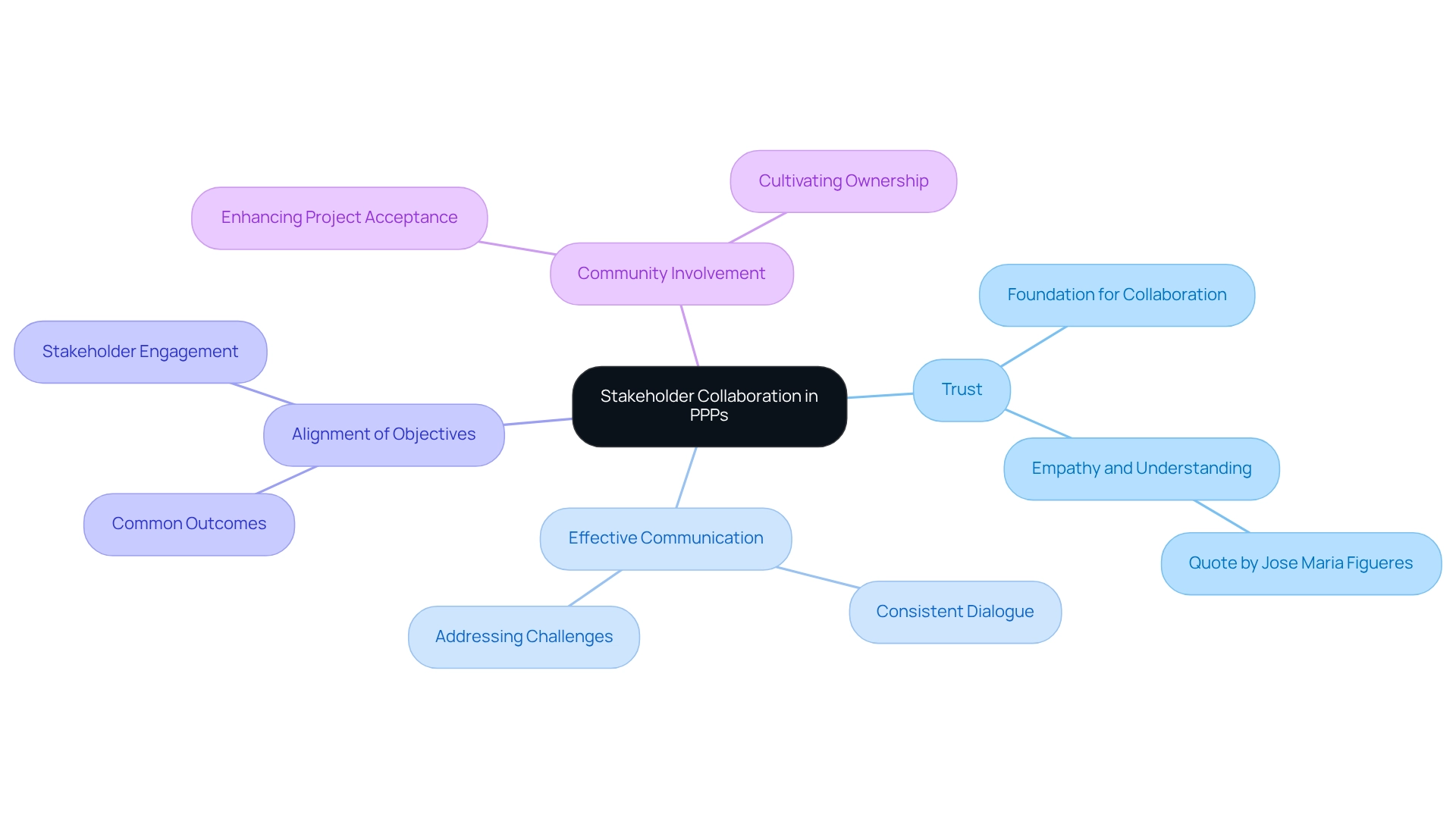
Future Trends in Public-Private Partnerships
Upcoming trends in public-private land development partnerships are poised to significantly transform the framework of land development and infrastructure initiatives. Noteworthy developments include:
- Increased Focus on Sustainability: Amid rising environmental concerns, PPPs are prioritizing sustainable practices and green technologies. This shift is not merely a trend but a necessity, as stakeholders recognize the long-term advantages of biodiversity and carbon sequestration in planning initiatives. Harbinger Land exemplifies this focus by delivering timely and accurate services that align with sustainability goals.
- Digital Transformation: The integration of digital tools and data analytics is revolutionizing project management and stakeholder engagement. However, a study revealed that only 16% of organizations reported enhanced performance from their digital transformation initiatives, underscoring the need for tailored strategies that address specific challenges in public-private land development partnerships. This statistic emphasizes the importance of understanding unique organizational contexts, particularly for land acquisition professionals.
- Greater Emphasis on Social Equity: Future PPPs will increasingly aim to deliver equitable outcomes for all community members. This approach seeks to address social inequalities and ensure that the benefits of infrastructure initiatives are widely distributed.
- Innovative Financing Models: Emerging financing structures, such as blended finance and impact investing, will support various infrastructure initiatives. These models are designed to attract a broader range of investors while promoting sustainability and social responsibility.
Current trends in sustainability practices show that as public-private land development partnerships evolve, there is a growing trend toward incorporating sustainability into every phase of project development. This encompasses not only environmental considerations but also social and economic impacts.
- Expert Opinions on Future Trends: Industry leaders stress the importance of adapting to these trends, noting that the future of public-private land development partnerships will depend on their ability to innovate and respond to changing societal needs. As Roz Savage wisely remarked, "It cannot be right to produce billions of items that are utilized for just a few moments, and then remain with us for hundreds of years," highlighting the necessity for sustainable methods across all areas of public-private partnerships.
- Statistics on Digital Transformation in PPPs: As organizations navigate the complexities of digital transformation, 44% express concern about establishing teams to drive this change. This statistic underscores the critical need for strategic planning and resource allocation in future PPP initiatives, particularly for those involved in land acquisition.
By embracing these trends, public-private partnerships can not only enhance their operational effectiveness but also contribute positively to society and the environment.
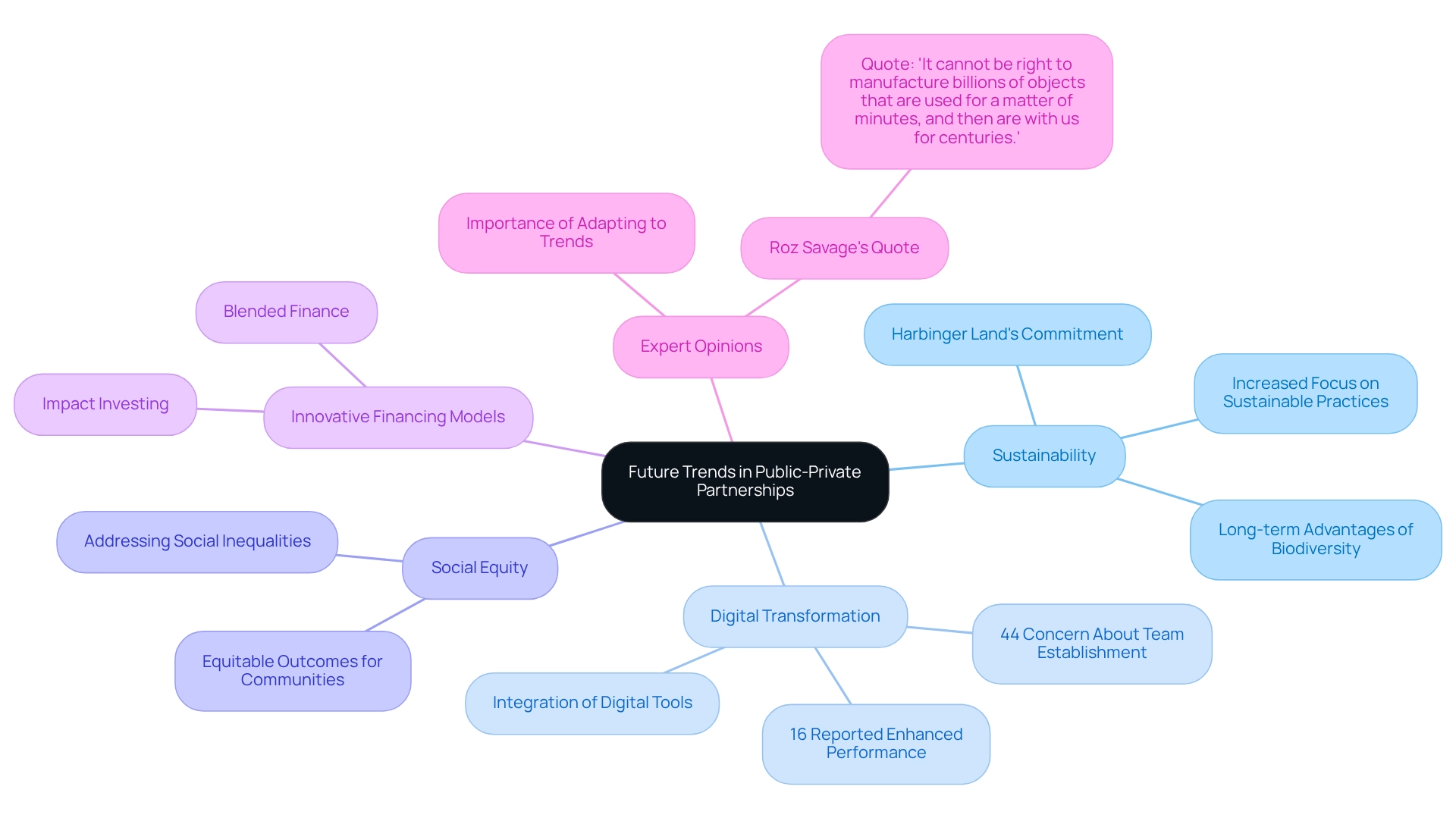
Conclusion
The exploration of public-private partnerships (PPPs) underscores their multifaceted benefits and challenges, particularly regarding land services for energy and infrastructure projects. Harbinger Land exemplifies how tailored solutions, driven by technology and collaboration, can enhance operational efficiency and align with sustainable development goals. By integrating advanced tools like AI and GIS mapping, the company effectively addresses the complexities of land acquisition while promoting responsible environmental stewardship.
Understanding the dynamics of PPPs—ranging from their shared risk models to innovative financing structures—highlights their significance in modern infrastructure development. The case studies presented illustrate how successful partnerships can lead to improved service delivery, faster project completion, and enhanced community engagement. However, stakeholders must also navigate potential pitfalls, including the complexities of long-term commitments and the necessity for clear communication and alignment of objectives.
Looking ahead, the future of PPPs appears promising. An increased focus on sustainability, digital transformation, and social equity is shaping the landscape. As these partnerships evolve, they present an opportunity to create lasting value for communities while addressing pressing societal needs. Embracing these trends is essential for stakeholders aiming to leverage the full potential of PPPs in fostering resilient and sustainable infrastructure development.
Frequently Asked Questions
What services does Harbinger Land provide for energy and infrastructure projects?
Harbinger Land offers customized land services including site and right-of-way acquisition, advanced title research solutions, GIS mapping, and document imaging services.
How does Harbinger Land enhance operational efficiency?
The company leverages cutting-edge technology such as AI-powered title research software and integrated GIS modeling to significantly enhance operational efficiency and client satisfaction.
Who are the typical clients of Harbinger Land?
Clients include natural gas firms, solar developers, and local governments, all of whom benefit from prompt and accurate services tailored to their unique needs.
What role does GIS modeling play in Harbinger Land's services?
GIS modeling facilitates efficient easements, enabling faster and more economical land acquisition, which is essential for renewable energy initiatives.
How does Harbinger Land address sustainable development?
The company aligns its services with the growing focus on sustainable development and environmental stewardship within the industry, particularly in renewable energy projects.
What are public-private land development partnerships?
Public-private land development partnerships involve collaborations between government organizations and private sector firms aimed at enhancing community services and infrastructure.
What are the key benefits of public-private land development partnerships?
Benefits include improved service delivery, enhanced investment efficiency, and the ability to leverage private sector innovation for public benefit.
What characteristics define public-private land development partnerships?
Key characteristics include shared risk, long-term commitment, performance-based contracts, and a focus on community benefits.
How significant are public-private land development partnerships in infrastructure financing?
They are critical for infrastructure financing, as evidenced by substantial investments in various initiatives, such as the $4.1 billion in water initiatives in developing countries reported in 2015.
Why is it important for stakeholders in land acquisition to understand public-private partnerships?
Understanding these dynamics can help stakeholders integrate public-private land development partnerships into their strategies, fostering improved outcomes and community benefits.
List of Sources
- Harbinger Land | Comprehensive Solutions for Land Services in Energy and Infrastructure
- Optimizing Energy Projects: Land Acquisition and Consulting for Sustainable Development (https://blog.harbingerland.com/optimizing-energy-projects-land-acquisition-and-consulting-for-sustainable-development)
- Land Acquisition Trends: What's Shaping the Market Today? (https://dev-res.com/press-and-news/land-acquisition-trends-whats-shaping-the-market-today)
- Public-Private Partnerships: Definition and Overview
- IDB Promotes Public-Private Partnerships to Attract Investment and Close Infrastructure Gaps (https://iadb.org/en/news/idb-promotes-public-private-partnerships-attract-investment-and-close-infrastructure-gaps)
- Recent Public Private Partnerships (PPP) news | UNECE (https://unece.org/media/economic cooperation and integration/Public-Private-Partnerships-(PPP)/news/recent)
- The Benefits of Public-Private Partnerships in Real Estate Development - Plaza Companies (https://theplazaco.com/knowledge-center/the-benefits-of-public-private-partnerships-in-real-estate-development)
- Private Participation in Infrastructure (PPI) - World Bank Group (https://ppi.worldbank.org/en/ppi)
- Types of Public-Private Partnerships Explained
- The Ultimate Guide to Public Private Partnership Financing The Ultimate Guide to Public Private Partnership Financing (https://highways.today/2025/04/13/public-private-partnership-financing)
- Public-Private Partnerships: Strengths and Weaknesses - 6035 Words | Essay Example (https://ivypanda.com/essays/public-private-partnerships-strengths-and-weaknesses)
- Advantages of Engaging in Public-Private Partnerships
- A couple of quotes in The National on the UAE’s new PPP Law. | Nicholas Kramer (https://linkedin.com/posts/nicholas-kramer-16358754_a-couple-of-quotes-in-the-national-on-the-activity-7154109151126695936-K3OB)
- The Benefits of Public-Private Partnerships in Real Estate Development - Plaza Companies (https://theplazaco.com/knowledge-center/the-benefits-of-public-private-partnerships-in-real-estate-development)
- Disadvantages to Consider in Public-Private Partnerships
- Public-Private Partnerships (PPPs): Definition, How They Work, and Examples (https://investopedia.com/terms/p/public-private-partnerships.asp)
- Real-World Examples of Successful Public-Private Partnerships
- ADB Bolsters Support for Public–Private Partnerships in the Philippines (https://adb.org/news/adb-bolsters-support-public-private-partnerships-philippines)
- Port Miami Tunnel Project | Port Miami Tunnel Project | Florida Department of Transportation District 6 (https://portofmiamitunnel.com)
- Leading Port Of Miami Tunnel To Success (https://enr.com/articles/7357-leading-port-of-miami-tunnel-to-success)
- Managing Risks in Public-Private Partnerships
- Managing Risks in Public Private Partnerships (PPP) in Housing in Nigeria: Methodological Perspective (https://academia.edu/29808647/Managing_Risks_in_Public_Private_Partnerships_PPP_in_Housing_in_Nigeria_Methodological_Perspective)
- fastercapital.com (https://fastercapital.com/content/Risk-Management--Mitigating-Losses-with-Closing-Quotes.html)
- Critical risk management strategies for the operation of public–private partnerships: a vulnerability perspective of infrastructure projects | Emerald Insight (https://emerald.com/insight/content/doi/10.1108/ecam-12-2023-1292/full/pdf?title=critical-risk-management-strategies-for-the-operation-of-public-private-partnerships-a-vulnerability-perspective-of-infrastructure-projects)
- Public-Private partnerships: strategic investment for comprehensive resilience (https://undrr.org/news/public-private-partnerships-strategic-investment-comprehensive-resilience)
- The Role of Stakeholder Collaboration in Public-Private Partnerships
- The 43 Best Quotes for Building a Strong Business Partnership - The Founder & The Force Multiplier (https://founderandforcemultiplier.com/the-43-best-quotes-for-building-a-strong-business-partnership)
- Future Trends in Public-Private Partnerships
- 45+ Key Digital Transformation Statistics (2025) (https://explodingtopics.com/blog/digital-transformation-stats)
- 80 of the BEST Quotes on Sustainability (https://nomomente.org/post/best-quotes-on-sustainability-eco-friendly-lifestyle)
- Sustainability quotes | Quotes about sustainability | Econation (https://econation.one/sustainability-quotes)




